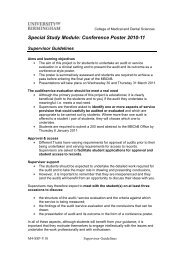Contents - College of Medical and Dental Sciences - University of ...
Contents - College of Medical and Dental Sciences - University of ...
Contents - College of Medical and Dental Sciences - University of ...
You also want an ePaper? Increase the reach of your titles
YUMPU automatically turns print PDFs into web optimized ePapers that Google loves.
The 11 th International Workshop on KSHV & Related Agents, Birmingham, UK<br />
Immunology I Abstract 9<br />
KSHV K5 COUNTERACTS TETHERIN, A NOVEL COMPONENT OF INNATE<br />
ANTIVIRAL IMMUNITY, TO FACILITATE VIRUS RELEASE<br />
Edward Tsao 1 , Sam Wilson 1 , Claire Pardieu 1 , Ben Webb, Imogen Lai, Stuart Neil 2 , Greg<br />
Towers 1 , <strong>and</strong> Paul Kellam 1<br />
1. MRC Centre for <strong>Medical</strong> Molecular Virology, Department <strong>of</strong> Infection, UCL, 46<br />
Clevel<strong>and</strong> Street, London W1T 4JF; 2. Peter Gorer Department <strong>of</strong> Immunobiology, 2nd<br />
Floor, Borough Wing, Guy's, King's <strong>and</strong> St Thomas' Hospitals, King's <strong>College</strong> London,<br />
Great Maze Pond, London SE1 9RT<br />
Abstract<br />
Tetherin (also called CD317, BST2, or HM1.24) has been identified as an interferoninducible<br />
human factor that inhibits the release <strong>of</strong> retroviruses, <strong>and</strong> its antiviral effect can<br />
be antagonised by HIV-1 vpu. It has been postulated that tetherin, a membraneassociated<br />
protein, is present both on plasma membranes <strong>and</strong> viral envelopes (acquired<br />
from the host membrane through viral budding). The interaction between virion- <strong>and</strong><br />
cell-associated tetherin molecules not only prevents virus release, but may also lead to<br />
endocytotic internalisation <strong>of</strong> the virions <strong>and</strong> their subsequent degradation. This model<br />
suggests that tetherin would be effective against all enveloped viruses. A recent<br />
proteomic study revealed that the levels <strong>of</strong> tetherin were strongly reduced in HeLa cells<br />
expressing KSHV K5. Here we show that 1) tetherin is expressed in PELs, that 2) KSHV<br />
K5 is required for the efficient release <strong>of</strong> virions from cells, <strong>and</strong> 3) in the absence <strong>of</strong> K5,<br />
the reduction <strong>of</strong> tetherin expression using shRNA rescues virus release. This is the first<br />
study to show that tetherin is active against enveloped DNA viruses, supporting the<br />
notion that it is an indiscriminate antiviral factor acting against enveloped viruses.<br />
Presenting author Email: e.tsao@ucl.ac.uk<br />
30















